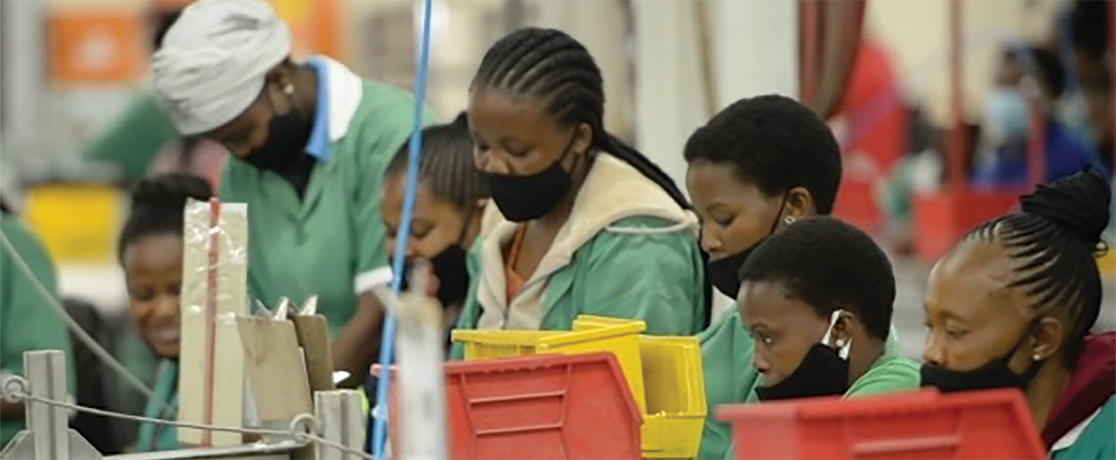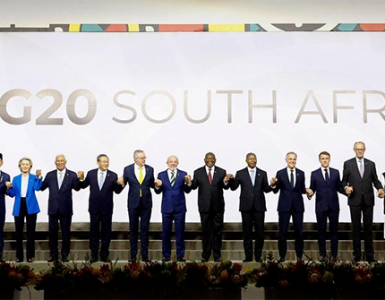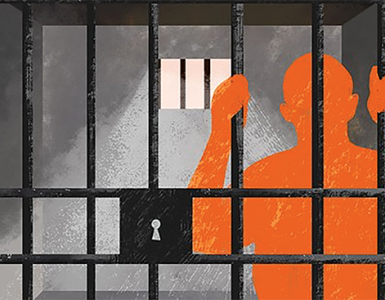DEPENDENCY: The devastating impact of Trump’s tariffs on the Kingdom prompted the government to declare a “state of disaster”, argues Pan Africanism Today’s Alasow Ghedi in this article, the economic crisis is a “violent outcome of a 150-year process that systematically eroded Lesotho’s economic sovereignty”…
ByJonis Ghedi-Alasow
In recent months, the unilateral and illegal tariffs imposed by the Trump administration have garnered much attention.
While much of the debate focuses on how these tariffs will impact US consumers and how US allies and adversaries are negotiating “deals”, the concrete impact of these tariffs on the lives and livelihoods of working people in the Global South has been largely overlooked. In March 2025, US President Donald Trump struggled to pronounce the name Lesotho, a place he claimed “nobody has ever heard of”. One month later, his administration threatened a 50% tariff on all goods from this small, mountainous kingdom of 2.3 million people. These were not claims made out of ignorance; they were an expression of “raw power”.
In this new era, the mediated rules of the World Trade Organization (WTO), though flawed, have been completely disregarded and undermined. What remains is a system where economic policy is used as a weapon. The real cost of a tariff is measured not only in the surrender of sovereignty at the altar of Washington but also in the material deprivation of thousands of people.
The government of Lesotho announced a two-year “state of disaster” in response. A disaster has indeed befallen the Basotho people, but this is not a natural catastrophe. This is a crisis deliberately created in Washington, the violent outcome of a 150-year process that systematically eroded Lesotho’s economic sovereignty.
To understand the full scale of this disaster, one must first dispel the colonial myth that African “development” depends on Western benevolence.
Before British rule was formalised in 1868, the Kingdom of the Basotho was a regional breadbasket. It was so productive that it was called “the granary of the Free State”. Basotho farmers produced large surpluses of grain, wool, and mohair, exporting 100 000 bags of grain in 1873 alone. This economic strength laid the groundwork for their political independence – an independence that colonial capitalism could not tolerate. The discovery of diamonds and gold in South Africa sparked an insatiable demand for cheap labour. To undermine the self-sufficiency of the Basotho people and force them into the socially destructive migrant labour system that underpinned colonial capitalism in South Africa, the British colonial administration used a powerful tool: the Hut Tax.
This tax, payable only in cash, was a deliberate act of social engineering designed to sever producers from their means of production. To comply with this cruel demand, Basotho men had no alternative but to abandon their farms and sell their labour to the white-owned mines in South Africa. This policy systematically dismantled the country’s agricultural foundation, turning a once-prosperous population into a dependent labour reserve economy.
This pattern of dependency persists. Mining jobs for Basotho people declined in the 1990s, following South Africa’s democratic breakthrough, which was followed by an overall decline in mining and a focus on South African labour over regional labour. Basotho miners, once a key part of the region’s economy, became economically redundant.
Global capital simply redirected its focus to a new, cheaper labour source: Basotho women. The growth of the textile industry, where women earned poverty wages ranging from USD 138 to USD 155 per month, facilitated by preferential trade agreements, was not a break from the colonial past but a direct continuation of the labour reserve model.
The foundation of this neo-colonial structure has been the US African Growth and Opportunity Act (AGOA). By providing duty-free access to the US market, the AGOA has driven remarkable growth in Lesotho’s textile sector, which employed around 40 000 workers, nearly all of whom were women.
However, this growth was a poisoned chalice, rendering the country’s entire manufacturing base utterly dependent on Washington’s political whims. AGOA was never intended to promote genuine industrialisation; it aimed to establish captive, low-wage assembly platforms for US capital.
The crisis in Lesotho exemplifies the broader struggle between US-led imperialism and the Global South. The path to liberation does not lie in negotiating better terms of dependency but in creating an alternative. The most vital strategic focus for African nations must be the African Continental Free Trade Area (AfCFTA). However, this should not become a “mercantilist” race to the bottom, where countries compete to export the most raw materials or basic textiles to fellow African nations.
This approach would only perpetuate the existing economic hierarchy. Instead, the focus should be on developing complementary industries that produce finished goods within the continent, thereby capturing a greater share of the value chain. The goal should be cooperative regional integration to improve collective industrial capacity and promote mutual prosperity.
While the ongoing, US-supported genocide in Palestine serves as the pivot around which the liberal order of “human rights” is collapsing, the persistent economic coercion of the Global South by the Trump administration similarly highlights the collapse of the liberal idea of a “rules-based international order”. The actual cost of the US tariffs is the neo-colonial subjugation and a return to overt, unabashed imperialism.
The response to this crisis must not be surrender, but rather the construction of a sovereign path through Pan African unity and regional economic integration. True independence will not be bestowed in the boardrooms of Washington. It will be achieved on the streets and in factories through the organised, collective power of the African people. – People’s Despatch
* Jonis Ghedi-Alasow is the coordinator of the Pan Africanism Today Secretariat
Comment
THE SCOURGE OF KIDNAPPINGS
The fatal shooting by the police of the most wanted suspected fugitive from justice linked to a string of kidnappings for ransom in South Africa and Mozambique could bring some slight relief to the spate of these crimes that had rocked both countries.
Nicknamed ‘’ Dollarman’’, the suspected criminal died in a hail of bullets during a shootout with the police near the R21 in Kempton Park last week. He was being sought by both the Mozambican and South African authorities for various crimes including kidnappings for ransom, housebreaking, carjacking and possession of unlicensed firearms. He was linked to at least five kidnappings for ransom cases in this country.
The breakthrough by the anti-kidnapping ask team in the taking down of the alleged kidnapping kingpin followed the recent Interpol African Regional conference which focused on unity and effective international police cooperation to fight crime .
This message seems to have triggered our police force into extra gear following the latest elimination of one of the most notorious criminals who had also recently masterminded the kidnapping of a Benoni businessman who was later found in a shack in Alexander and safely reunited with his family.
Kidnappings are mostly perpetrated for financial gain and in some incidents, the money was used to fund terrorist activities. These kind of crimes in South Africa have reached alarming proportions with a total 17 061 incidents reported countrywide in the 2023/2024 financial year. According to the South African Police Services crime statistics, an alarming 4300 kidnapping cases were reported between July and September this year. Kidnappings in the Gauteng province – the hub of kidnappings in South Africa – these incidents increased from 2085 in the 4th quarter of the 2023/2024 financial year to 2414 in the same period for the 2024/2025 year. Gauteng has also been described as a major contributor, nationally, with 52,8 percent of these incidents.
The police must be lauded for the job well done but more needs to be done to restore their tarnished image and to ensure that South African citizens are always safe in their homes and in the streets.
The rise in kidnapping incidents are believed to be driven by organized criminal syndicates with ransom -related abductions being the most common motive. Now that one of the kingpins have been eliminated, the police must intensify their investigations and flush out those who were colluding with him to commit these crimes. Police spokesperson, Brigadier Athlenda Mathe has indicated that from July 2021 to date, a total 337 suspected kidnappers had been arrested by the anti-kidnapping task team and more than 146 illegal firearms had been seized at the crime scenes. Police were achieving breakthroughs in investigations of kidnap for ransom cases. The recent explosive allegations by KwaZulu – Natal provincial Commissioner, Lt.Gen. Nhlanhla Mkhwanazi that certain police chiefs were colluding with dangerous criminal syndicates – one of the many reasons why the police could not win the fight against crime – should be taken very seriously.
What the South African Police Services needed now is nothing but credible leaders who will not be tainted by criminal elements.






























